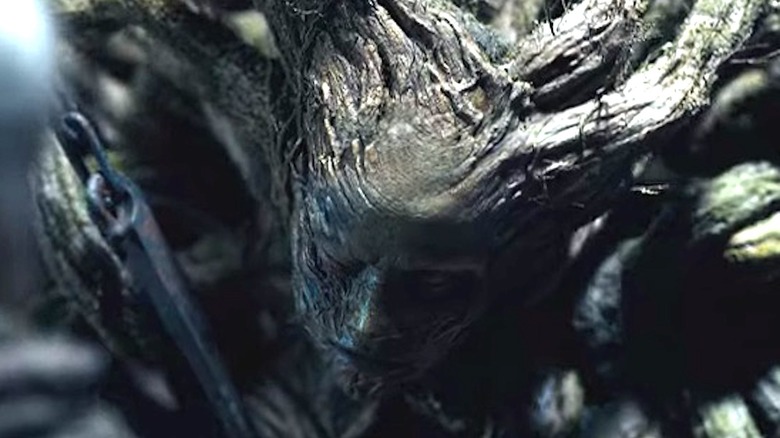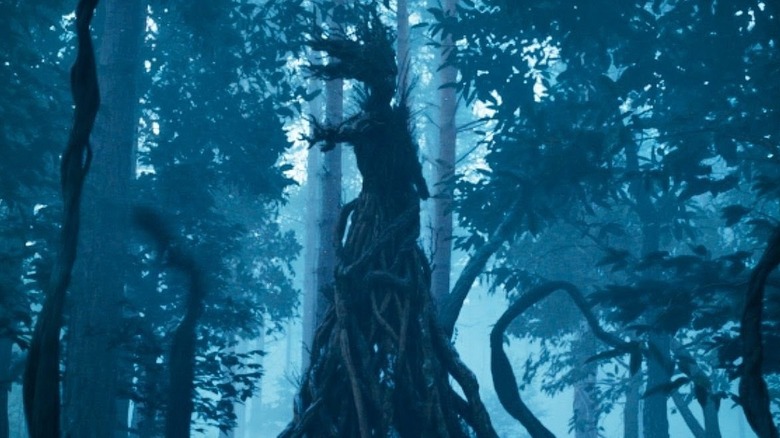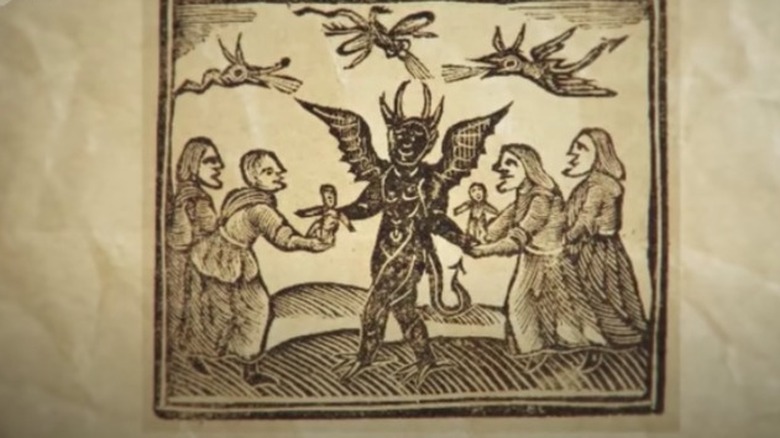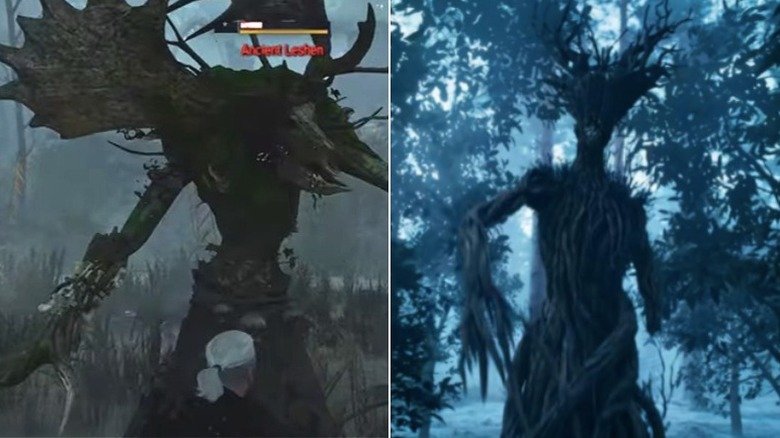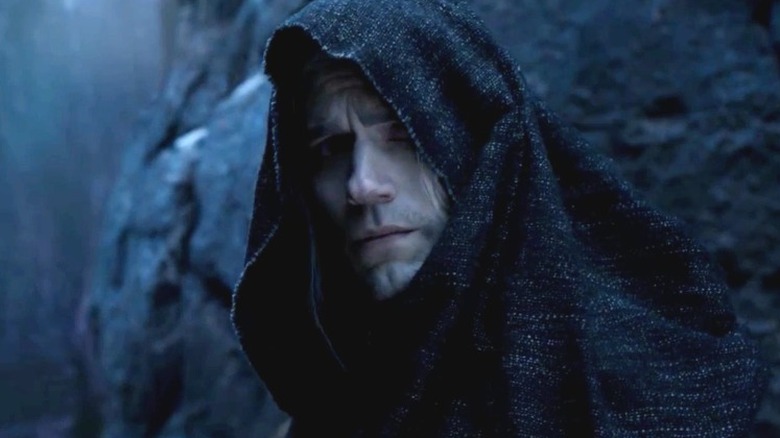The Leshen In The Witcher Season 2 Explained
Immediately after the trailer for Season 2 of Netflix's "The Witcher" hit the internet, Lauren S. Hissrich's adaptation of Andrzej Sapkowski's beloved novels and stories made headlines, particularly amongst fans of CD Projekt Red's popular video game series. For the first time, the television adaptation teased it would include a monster that, while featured prominently in the games, isn't much of an element in the books: the fearsome, forest-dwelling Leshen. As u/cutiecalm1 wrote on "The Witcher" subreddit r/witcher, "The (leshen) has always been my favorite monster from the 'Witcher' (games), so I'm excited to see it make its debut in the show."
For fans of the books who've never played "The Witcher" games, it might seem odd to add this creature to Netflix's version of the book-inspired universe. However, a closer look at the lore behind the Leshen (sometimes also known as the Leshy) suggests the series knew exactly what it was doing in including the storied monster. In addition to just happening to look extraordinarily cool and scary, Sapkowski's little-mentioned but nonetheless present "tree monster" speaks to an ongoing theme in both the novels and the series. That is, the idea that humans are actually responsible for the creation and behavior of some of their most horrifying opponents (see, also: the Sylvan from Season 1).
Sapkowski didn't invent the Leshy, but he did draw on its mythological origins for his books
By his own enthusiastic admission, author Andrezj Sapkowski borrowed heavily from and built on the mythologies of a number of cultures and traditions while creating the various monsters and plot devices that permeate and characterize The Continent. As he told Lithub in a December 2020 interview, "It would be easier to name the mythologies and cultures I DIDN'T draw on. Because there were — just to mention a few — Slavic mythology: vampires, leshies, kikimoras, vodyanoys. There was the Germanic Wild Hunt. The Portuguese bruxa. The Arabic ghul. The Scottish kilmoulis ..."
Although the "leshies" — or the "leshy," as it's called in the books — to which Sapkowski refers don't play a true role in his work, its existence is mentioned several times. Typically, the Leshy pops up when a character is listing-off monsters or theorizing on what kind of monster could have done something, as in "The Last Wish" (via Goodreads), or when a character is pointing to the many responsibilities of a Witcher, as it occurs in "Blood of Elves" (via Goodreads). If the leshy looms so large in readers' brains, it has less to do with Sapkowski's characterization of it (since there isn't one) and more to do with the fact that the notion of the leshy, frequently a tree-presenting, shape-shifting wood demon and protector of the forest, has existed in the mythological imaginations of a number of cultures for centuries.
The Leshy has its roots in ancient Slavic mythology
Much like the long-held oral tradition at the root of Norse mythology, Slavic and many other Eastern European mythologies have origins that are difficult to trace. However, a few things we know about this mysterious monster. 1872's "Songs of the Russian People" dives deep into the history of the Leshy. "The [Leshy] is malicious," author W.R.S. Ralston writes, "And to those who do not conciliate him he often does such mischief ... in olden days when the forests were larger and denser than they are now, the [Leshy] used to be constantly deluding travelers, and making them lose their way" (via Google Reads). Though in many Slavic traditions, the Leshy is portrayed more like a kind of "Respect the Forest" Smokey the Bear type mixed with a Loki-level trickster than he is a true force of evil, it is eventually (like many a pagan creature) given a demonic makeover with the spread of Christianity, according to the PBS series "Monstrum" (via YouTube).
"Monstrum" also reveals that what began as a forest-dwelling mischief-maker who loved messing with travelers, gambling its forest resources with other Leshy, and receiving offerings of bread and salt was then given cloven hooves (Christian code for "a real villain") and branded a demon. Over time, peasants went from believing that they could protect themselves by making a Leshy laugh to feeling compelled to throw the sign of the cross at it. This more fearsome and monstrous depiction of the creature — who, in almost all tellings, can shape-shift into various flora and fauna of the forest, as he does in "The Witcher" video games — is likely the one Sapkowski had in mind.
Season 2's Leshen looks a little different than it does in the game
Clearly, Andrezj Sapkowski's Leshy is no card-playing forest trickster, but his appearance in the novels (combined with his mythological origins) suggests that the monster may act as yet another manifestation of the less than savory behavior of humans. The Leshy is, after all, a protector of the natural environment. CD Projekt Red's Leshen (via "The Witcher" wiki) shares many a characteristic with its centuries-old Slavic relative. It has, for instance, the ability to shape-shift into a murder of crows, as one Reddit user points out, and it's given various attributes of creatures that might dwell in a forest. It stands much taller than a human man, or even a Witcher, too.
On "The Witcher" Season 2, the terrifying monster loses the antlers but maintains its awe-inspiring height and gains the ability to move, grow, wind, twist, use its branches like fearsome tentacles, and change form in truly wicked ways. The Leshy of Slavic mythology can grow to the size of a tree and shrink to no taller than a blade of grass, and can take on the form of whatever creature it likes, per PBS' "Monstrum." This plays out in Season 2 when a mutated Leshen finds its way into the body of Eskel (Basil Eidenbenz), Geralt's (Henry Cavill) good friend and a fellow Witcher. It alters his behavior and eventually takes over his entire body, turning the monster killer into a monster. Sadly, when the Leshen-consumed Eskel nearly strangles Geralt's mentor, Vesemir (Kim Bodnia), Geralt is forced to kill his long-time friend. Vesemir struggles to understand how the Leshen could have mutated in such a way, and Geralt ultimately teams up with Royce Pierreson's Istredd to find out.
Geralt and Istredd's conversation about monoliths explains the Leshen's power
Despite all the truly bonkers things he's seen in his many (many, many) years fighting monsters, Geralt rejects Istredd's claim that the ancient monoliths he's been studying might hold the key to the Leshen's mutated powers. Undeterred by Geralt's skepticism, Istredd insists that he has felt the monoliths vibrating and communicating with one another. In his opinion, this means the monoliths aren't left-over "collision points" from the Conjunction of the Spheres, as it has long been believed. Instead, Istredd feels they are alternately active and inactive portals through which the ancient creatures of other worlds and spheres can enter that of The Continent, the mutated Leshen included.
In Season 1, Ciri (Freya Allan) topples the great monolith on the outskirts of Cintra in her desperation to break free from Nilfgaard's Black Knight (Eamon Farren's Cahir). Though Geralt doesn't understand where Ciri's immense, uncontrollable powers come from, her connection to the monoliths — coupled with her ability to sense exactly where the Leshen is in the woods — suggests early on that she may be behind the newfound unpredictability of the long-held laws of The Continent.
In Season 2, Episode 8, "Family," Istredd's theory proves correct. While possessed by The Deathless Mother, Ciri erects a new monolith at Kaer Morhen through which a dizzying array of heretofore unheard of monsters emerge, supporting (among other things) that belief that the mutated Leshen to whom Ciri feels drawn is actually the result of her toppling the monolith in Season 1.
